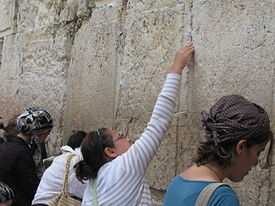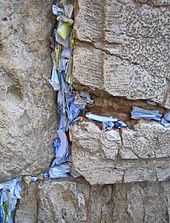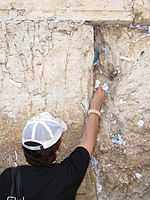Placing notes in the Western Wall

Placing notes in the Western Wall refers to the practice of placing slips of paper containing written prayers to God into the cracks and crevices of the Western Wall, a Jewish holy site in the Old City of Jerusalem.
The earliest recorded occurrence of such a phenomenon dates from the early 18th century and stems from the Jewish tradition that the Divine Presence rests upon the Western Wall. Over a million notes are placed each year in what has become a custom, not only for tourists, but also for high-profile dignitaries visiting Israel from abroad. The notes are collected twice a year and buried on the nearby Mount of Olives.
History

The practice of placing prayer notes into the cracks and crevices of the Western Wall began over 300 years ago. The earliest account of this practice is recounted by the Munkatcher Rebbe and is recorded in Sefer Ta'amei Ha-minhagim U’mekorei Ha-dinim. The story involves Rabbi Chaim ibn Attar, the Ohr Hachaim, in Morocco. A certain man came to him in great distress after he had become so destitute that he couldn’t afford to buy food for his family. The Ohr Hachaim wrote him an amulet in Ashuri script on parchment and instructed the man to place it between the stones of the Western Wall.[1] Another story is told involving a student of the Ohr Hachaim who planned to emigrate to Jerusalem from Morocco. The Ohr Hachaim instructed him to place a note in the Wall upon his arrival. The pupil, who later became famous as the Chida, attributed his personal success to the note, which read, “Dear God, please let my student Azulai become successful in Israel”.[2]
The rationale behind placing prayer notes in the Wall has been traced to the Midrashic teaching that the Divine Presence has never moved from the Western Wall,[3] and the Kabbalistic teaching that all prayers ascend to Heaven through the Temple Mount, which the Western Wall abuts.[2][4][5]
Modern-day practice

Today, more than a million prayer notes or wishes are placed in the Western Wall each year.[6] Notes that are placed in the Wall are written in just about any language and format. Their lengths vary from a few words to very long requests. They include poems and Biblical verses. They are written on a wide variety of papers, including colored paper, notebook paper and even bubblegum wrappers, using a variety of inks.
Rabbi Shmuel Rabinovitch, Rabbi of the Western Wall, receives hundreds of letters yearly addressed to "God, Jerusalem"; he folds these letters and places them, too, in the Wall.[7]
Online services offer petitioners the opportunity to send their notes to the Western Wall via e-mail, fax, text messaging and Internet; the note is then printed out and inserted in the Wall.[8] The Israeli Telephone Company has established such a fax service,[9] as have a number of charitable websites.
Based on the cherem of Rabbeinu Gershom which prohibits reading another person's mail, it is halakhically forbidden for a Jew to read a note that has been inserted in the Western Wall.[10]
Disposal of notes
According to Jewish law, prayer notes may not be thrown away; there is a difference of opinion as to whether they should be burned or buried. According to Rabbi Shmuel Rabinovitch, Rabbi of the Western Wall and author of Minhagei HaKotel, a book of halakhot about the Western Wall, burning is a "pure" way to deal with the notes, but burying them is more honorable.[7] Twice a year, Rabbi Rabinovitch and his assistants collect the notes left in the Wall and bury them in the Jewish cemetery on the Mount of Olives.[7]
Notable persons who have placed notes in the Wall
The tradition of leaving notes for God in the Western Wall has also been adopted by Christian pilgrims and people of other faiths.[7] Foreign dignitaries who have publicly placed a kvitel in the Western Wall include Pope John Paul II in 2000,[11] U.S. Senator Hillary Rodham Clinton in 2005,[12] and Pope Benedict XVI in 2008.[13]
In July 2008, U.S. presidential candidate Barack Obama placed a written prayer in the Wall.[14] After Obama and his entourage departed, his note—written on hotel stationery—was removed from the Wall by a seminary student who sold it to the Maariv newspaper. The newspaper published the note, prompting criticism from other news sources and from the Rabbi of the Western Wall for violating the privacy that is inherent in notes placed in the Wall.[15]
In 2009, Pope Benedict XVI deposited a message in the Wall, and released its contents to the media.[16]
In July 2012, U.S. presidential candidate Mitt Romney placed a written prayer in the Wall.[17] His note was later moved to a different location in the Wall for privacy reasons and to avoid a repeat of the incident with Obama's note in 2008.[18]
See also
References
- ↑ Sperling, Avraham Yitzchak (1999). Sefer Tamei Ha-minhagim U’mekorei Ha-dinim; Inyanei Hilula D’Rashbi, p. 270. Jerusalem: Shai Le-morah Publishing.
- ↑ 2.0 2.1 Simmons, Rabbi Shraga. "What is the Origin, Process and Reason Behind Placing Notes in the Western Wall?". about.com. Retrieved 2010-01-13.
- ↑ Exodus Rabbah 2:2.
- ↑ Pirke De-Rabbi Eliezer 35: "Anyone who prays in this place in Jerusalem, it is as if he prayed before the Throne of Glory, for the gate of heaven is there, open to hear all prayers".
- ↑ Simmons, Rabbi Shraga (3 November 2002). "Six Reasons Why The Wall Is Holy". Retrieved 6 October 2010.
- ↑ McGirk, Tim (25 July 2008). "Obama's Private Prayer 'Leaked'". Time. Retrieved 2 October 2010.
- ↑ 7.0 7.1 7.2 7.3 "Where Do All the Prayer Notes Go?". ABC-Australia news report. 5 September 2007. Retrieved 2010-01-18.
- ↑ "Not in Yerushalayim? Send a Kvittel to the Kosel via Twitter". matzav.com. 22 July 2009. Retrieved 2010-01-18.
- ↑ Starr, Joyce Shira (1995). Faxes and Email to God: At the Western Wall of Jerusalem. iUniverse. ISBN 978-1-893652-37-8.
- ↑ Shevet HaKehusi 1:315:1, quoted in Lebovits, Rabbi Moishe Dovid, "Reading Another Person's Mail", Hamodia Features, 6 January 2010, p. C3.
- ↑ "Letter Placed by Pope John Paul II at the Western Wall". Ministry of Foreign Affairs (Israel). Retrieved 2008-10-07.
- ↑ Associated Press (15 November 2005). "Hillary Clinton visits Western Wall". Haaretz. Retrieved 5 April 2011.
- ↑ "Pontiff Visits Judaism's Holiest Site, the Western Wall". necn.com. 12 May 2009. Retrieved 2010-01-18.
- ↑ McGirk, Tim (2008-07-25). "Obama's Private Prayer Leaked". Time.
- ↑ "Rabbi Condemns Release of Purported Obama Prayer Note". CNN. 27 July 2008. Retrieved 2010-01-18.
- ↑ "Pope Places Note of Peace in Jerusalem's Western Wall". Canadian Broadcasting Corporation. 2009-05-12. Retrieved 2009-05-31.
- ↑ Haake, Garrett (29 July 2012). "Mitt Romney visits Western Wall, one of holiest sites in Judaism". NBC News. Retrieved 23 October 2014.
- ↑ Tepper, Greg (30 July 2012). "Romney's Western Wall Note Removed". The Times of Israel. Retrieved 23 October 2014.
External links
| Wikimedia Commons has media related to Notes in the Western Wall. |